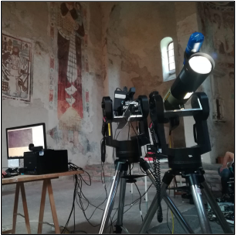Service: Remote and Short Distance VIS/NIR Spectral Imaging For Large Area Survey and Large Collections Survey
Platforms
Fixlab
Molab
Techniques
Remote vis/nir spectral imaging for large area survey

Organization
United Kingdom
Service contact persons
Mapping of original materials, degradation products and conservation materials for large areas and large collections; Revealing drawings and text; Preliminary identification of materials, mainly pigments and dyes; 3D point-cloud and accurate colour images for documentation.
Visible to near-infrared spectral imaging is an efficient method of collecting reflectance spectra over an area, allowing material mapping over a large region and enabling identification of most pigments commonly used in historical artworks. The PRISMS 10 band spectral imaging system is designed for rapid collection of reflection spectra of large collections, large surfaces and/or remote imaging of regions at inaccessible heights. Automated scanning can be carried out by coupling PRISMS with a computer-controlled pan/tilt motorised stage, allowing material analysis at high spatial resolutions over a large area or multiple objects.
This technique can provide material mapping of areas which share similar reflectance spectra. Preliminary identification of these materials (e.g. the identification of the original materials, degraded areas and areas of past interventions) can also be provided based on their spectral reflectance. The ability to distinguish regions of differing material composition can also reveal hidden information such as faded drawings, writings and preparatory sketches.
By identifying regions of similar material composition, the system can provide a basis for targeted analysis with complimentary techniques such as remote Raman spectroscopy. This system can provide similar levels of pigment identification as higher spectral resolution systems, except for a handful of pigments where there are sharp spectral features, such as Cobalt based pigments and anthraquinone dyes (e.g. madder and cochineal).
The spectral image cubes can also be used to construct RGB colour images with a high colour accuracy. Large area scanning can be done automatically and data can be mosaiced to produce high resolution large area images.
Fields of application
Archaeological conservation
Archaeology
Art history
Heritage science (cultural heritage discipline)
History (discipline)
Materials science
Philosophy
Materials
pigments and dyes on any substrate
Ceramics
Glass
stone
Metal
Textiles
wood
Paper
degradation products
conservation materials
Methods
Other information
-
Input: Colour image of the object imaging region Information on room/space layout and distance to the object/structure Object information- dimensions etc
-
Output: colour images, e.g. RGB, CIE L*a*b* (file format negotiable) spectral image cubes (file format negotiable) ASCII meta data file All data are linked through the MAPSI app with measured areas marked and any comments on the data

